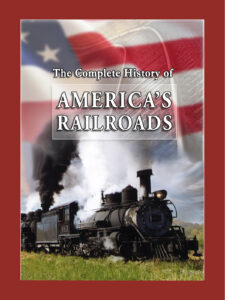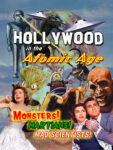
The Complete History of American Railroads video, an impressive and comprehensive story of the development of railroading in America. Rail enthusiasts as well as history buffs, teachers and homeschoolers, plus kids of all ages will appreciate this magnificent train adventure covering live-action historic operating railroads, rare photos of drawings and valuable memorabilia, and live-action re-enactments. Featuring spectacular cinematography and an inspiring musical score, this Award-Winning four-part video covers over one-hundred years of transportation and railroading evolution. Part One — A WILD AND IMPRACTICAL SCHEME 1800 — 1845. In 1845 John Stevens obtained a charter form the New Jersey legislature to build the first steam railroad in America, but he could not get financial backing because no one believed it could be done. However, eventually the concept caught on and investors realized that trains would become faster, cheaper, and could haul more freight than any other type of transportation. Although the steam locomotive was originally invented in England, by 1830 America’s first locomotive, Tom Thumb made its first trial run for America’s first chartered railroad, The Baltimore and Ohio. Part Two — ONE NATION INDIVISIBLE 1845 — 1865. By the 1850s railroads were not only capturing the eyes of savvy businessmen, they were capturing the hearts of the people as well bright-colored engines with fancy scrollwork, billowing smoke and hard-driving wheels, shrill whistles, and memories of trips to friends and relatives. Railroads determined the location of towns, opened new lands to the West, and were a vital factor in the outcome of the Civil War. Part Three — TRANSCONTINENTAL EXPANSION 1865 — 1880. For years people dreamed of the time when trains would reach the Pacific Ocean. It would enhance trade with California and the Orient. The Union Pacific began building west from Omaha, and the Central Pacific east from Sacramento. But there were problems weather, lack of money and labor, mountains, rivers, deserts, and Indian raids. However, after the Civil War, investment money was abundant for rail expansion including land grants, and payment of immigrant, former slave, and Chinese laborers. On May 10, 1869, at Promontory Summit, Utah, a golden spike joined east and west by rail! Part Four — THE GOLDEN AGE 1880 — 1916. By 1900 five different railroads had reached the Pacific Ocean, and between the Atlantic and Pacific America’s vast landscapes were being connected by a spider web of rails. For railroads, there was no competition. No industry dominated the American scene, or so touched every aspect of American life, as did the railroad during its Golden Age. For railroads, it was a time of major improvements including the telegraph, air brakes, bridge building, automatic couplers, standardized time zones and track gauge, and bigger and more powerful locomotives. During this time, George Pullman improved the comfort of passenger travel while Fred Harvey developed cross-country restaurants to serve the needs of weary travelers. If you love trains you will love this railroad video.




